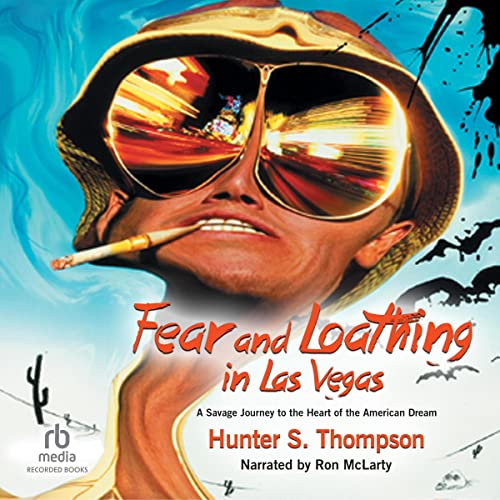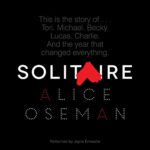Fear and Loathing in Las Vegas Audiobook
Hi, are you looking for Fear and Loathing in Las Vegas audiobook? If yes, you are in the right place! ✅ scroll down to Audio player section bellow, you will find the audio of this book. Right below are top 5 reviews and comments from audiences for this book. Hope you love it!!!.

Review #1
Fear and Loathing in Las Vegas audiobook free
This book stands as a significant milestone in literary history. While Hunter S. Thompson had authored books and contributed to numerous articles prior to this, “Fear and Loathing in Las Vegas” marked the turning point in his career, catapulting him to fame. It also introduced the world to the concept of Gonzo journalism, with the term itself coined within its pages.
So, what exactly is Gonzo journalism? Thompson, though officially a journalist, held a unique perspective on the profession. He rejected the idea of journalistic objectivity as a myth and an undesirable ideal. In its place, he championed Gonzo journalism, which he described as “telling it as it is.” In this style, Gonzo journalists openly infused their emotions into their stories.
To illustrate, while a conventional journalist might neutrally report a politician’s speech, a Gonzo journalist would relay the speech’s content but might also interject personal opinions, such as branding the speech as foolish and untrustworthy due to the politician’s perceived deceit.
While Gonzo journalists were not expected to concoct entirely fictional narratives, they often manipulated events for better storytelling, emphasizing or downplaying elements and occasionally introducing a touch of fiction to enhance the narrative.
Gonzo journalism gained some recognition and popularity following “Fear and Loathing,” but it truly exploded in the age of the internet and the proliferation of private blogs.
Officially, the book isn’t a work of fiction but rather an autobiographical novel chronicling Thompson’s journey to Las Vegas in 1971, where he covered both the Mint 400 race and a narcotics police convention. It’s known that he did attend these events, albeit not within the tight timeframe presented in the book. The debate continues about what in the book is genuine and what is fictional. However, for the purpose of this review, I take the book “as it is.”
“Fear and Loathing in Las Vegas” follows the escapades of journalist Raoul Duke (Thompson’s alter ego) and his Samoan attorney, referred to only as Dr. Gonzo. Duke is assigned to cover the Mint 400 race, and Dr. Gonzo tags along. They embark on their journey in a conspicuous red Cadillac, packed to the brim with various drugs. Days later, they return to cover a police convention on narcotics. In the interim, they also embark on a quest to find the elusive American Dream, without a clear understanding of what it entails.
The two protagonists are perpetually under the influence of drugs, and their conversations and actions oscillate between the bizarre, paranoid, and outrageous. It’s often unclear whether they are under the influence or not. The situations they encounter range from comical to violent, sad, bewildering, and occasionally all of the above combined. Strangely enough, despite their sometimes borderline criminal behavior, no one reports them to the authorities. This portrayal strikes a chord with reality, as people tend to react in various ways when confronted with eccentric behavior. Some may dismiss it as a joke, others might be too shocked to respond, and some may simply play along to avoid further complications.
However, the book delves deeper than the escapades of “two junkies gone wild.” It touches on several key themes. Three major ones stand out:
- Drugs: The 1960s saw a surge in drug popularity, initially associated with rebellion against authority and the old order. However, drugs soon became a means of escaping reality rather than a form of entertainment. This shift represented a betrayal of the 1960s ideals, which aimed at positive societal change rather than isolation.
- Ridiculing Authority: The book relentlessly satirizes authority figures, portraying them as inept, corrupt, or absurd. This treatment extends to police, politicians, celebrities, and even religious figures. The depiction of a narcotics police conference as a farce exemplifies this theme.
- The American Dream: Duke and Dr. Gonzo embark on their journey in search of the American Dream, despite their unclear understanding of it. For many, the American Dream equates to economic success, and Las Vegas, a city built around casinos, epitomizes the pursuit of wealth. However, the book highlights the hollowness of this pursuit, revealing that the house always wins in such places.
The narrative also critiques consumer society, emphasizing the pointlessness of accumulating wealth without purpose. Duke and Dr. Gonzo engage in disruptive, disrespectful behavior towards consumer culture, from evading hefty hotel bills to casually damaging expensive property.
In the end, the book does lead the characters to an entity named the “American Dream,” a psychiatric club consumed by local junkies, serving as a metaphorical commentary.
“Fear and Loathing in Las Vegas” remains a captivating read with enduring relevance. The socio-political landscape it portrays bears striking similarities to contemporary America: an unpopular war fueled by deception, an increasingly powerful and opaque authority, politicians serving corporate interests, and the illusion that everything remains normal while underlying economic and social crises simmer.
Review #2
Fear and Loathing in Las Vegas audiobook
Worth giving a shot as long as you approach it with modest expectations. While it contains a few valuable nuggets, such as his observations on the inner workings of Vegas and the drug-fueled musings, it falls short of its full potential. However, it’s a swift and easy read. Imagine if we could transport the author to the present day and encourage him to pen a sequel – wouldn’t that be an intriguing prospect?
Review #3
Audiobook Fear and Loathing in Las Vegas by Hunter S. Thompson
I adored this book. It was a truly delightful read, and the vivid descriptions of the acid trips were exceptional. I found it highly enjoyable and would absolutely recommend it!
Review #4
Audio Fear and Loathing in Las Vegas narrated by Ron McLarty
Essencial para compreender a relevância do espírito de rebeldia social e política apresentado por Hunter S. Thompson; constitui uma análise excepcional do que se esconde por baixo da superfície da sociedade americana desde os anos 60 até os dias atuais. Além disso, proporciona momentos de grande humor.
Review #5
Free audio Fear and Loathing in Las Vegas – in the audio player below
This book didn’t earn critical acclaim upon its initial release, and with the passing of over four decades, it has failed to stand the test of time. Undoubtedly, it possesses a certain enchantment, which explains why Hunter Thompson’s devotees regard it as a classic. Nevertheless, for most contemporary readers, attempting to engage with this work will likely result in disappointment.
I personally decided to explore it due to my interest in delving into the psychological nuances of different cultural eras in American history. From this particular perspective, the book manages to hold one’s attention, despite its excessive self-indulgence. Originally published in 1971, it offers an intense snapshot of the American zeitgeist at that precise moment. The fiery idealism of the 1960s had mostly faded, leaving behind emotional wreckage. The once-strong ideals were deteriorating into nihilism and self-destruction. Hunter Thompson ingeniously transports us to the surreal world of Las Vegas, an ideal backdrop to observe this disintegration. He uses his own body and soul as a metaphor for this societal waste.
Thompson employs his renowned “Gonzo Journalism” style, meaning that while the book lacks a substantial plot, the narrative is rooted in a stylized version of reality. He serves as the protagonist, and his constant companion, referred to only as “my attorney,” is his real-life friend Oscar Acosta. This oversized and menacing figure offers a comedic contrast to Thompson’s wiry and cerebral persona. Despite their differences, they share a similar provocative outlook on their surroundings, forming the emotional core of the book.
The story begins with Thompson, based in Los Angeles, receiving a journalistic assignment from a “fashionable sporting magazine” (in reality, Sports Illustrated) to cover the annual Mint 400 off-road race in the desert near Las Vegas. Thompson and his attorney don flashy Acapulco shirts, rent a flashy car, and embark on their journey to Las Vegas. It becomes evident early on that these two are unlike any “drug enthusiasts” the reader might have encountered. Before setting off, they amass a vast assortment of mind-altering substances, including cocaine, mescaline, hashish, LSD, amphetamines, raw ether, alongside ample quantities of tequila, bourbon, rum, and a case of Budweiser beer. Throughout their desert odyssey, they liberally sample this potentially lethal array of substances, all while acutely aware of Nevada’s severe drug laws.
By the time they reach the Mint Hotel, their intoxication has reached extreme levels. Thompson’s hallucinations depict the hotel lobby teeming with hostile reptilian creatures, and the carpet appears to be submerged in ankle-deep blood. Yet, despite their precarious mental states, their codependency ensures that one of them maintains enough composure to handle practical matters. The race is imminent, and Thompson’s attorney assists him in securing press credentials. They subsequently retreat to their room and counter the effects of the hallucinogens with copious amounts of whiskey. Remarkably, this remedy allows them to retrieve their car and drive to the race’s starting point outside of town.
By this point, Thompson is back in professional mode. However, he quickly realizes that there’s no conventional method for a reporter to cover such an event. Bored with the assignment, he mingles with drivers, mechanics, and spectators, gathering enough material to believe he can fabricate a credible article later on. He and his attorney return to the city, where they resume their debauchery, resulting in increasingly bizarre and dangerous encounters, including car accidents, confrontations with casino bouncers, and frightening encounters with fellow revelers.
At one juncture, Thompson’s attorney abruptly departs for Los Angeles on urgent business, leaving Thompson alone and descending into a state of helplessness and paranoia. He believes he has failed in his journalistic endeavor, lost all his money, and misplaced his credit cards. Fearing he might not even manage to return to Los Angeles, he encounters a telegram from his attorney, instructing him to remain in Las Vegas for another reporting job.
This new assignment, from Rolling Stone magazine, involves covering a national district attorney’s conference addressing America’s drug crisis—a job that strikes Thompson as ironically fitting. The narrative takes a darker turn as Thompson and his attorney encounter weapons, including guns and knives, during increasingly unsettling incidents. There is a growing sense of imminent danger, and the book hints at the possibility of violence.
The book lacks a traditional plot structure, ending somewhat abruptly without a clear resolution. It introduces the notion of chasing the American Dream, but this theme reads like self-parody rather than a serious exploration.
Politically, Hunter Thompson is often associated with leftist ideologies, but his love for guns and previous interactions with the Hell’s Angels has confounded those who try to categorize him. If anything, he can be seen as an anarchist in rebellion against all belief systems. Thompson’s experiences, as depicted in “Fear and Loathing in Las Vegas,” could be interpreted as an erudite portrayal of a manic-depressive episode.
Unfortunately, the lives of the book’s two protagonists did not end well. Oscar Acosta disappeared in Mexico in 1974, believed to have been murdered by criminal associates. In 2005, Hunter Thompson took his own life, leaving a suicide note that made light of his demise. In accordance with his wishes, his ashes were shot from a cannon amid a fireworks display, a spectacle viewable on YouTube today.
Charismatic individuals with manic-depressive tendencies often draw others into their manic episodes. Hunter Thompson was an accomplished writer who could achieve this effect through literature. I recommend this book to those who wish to experience what it’s like. However, it’s important to note that it may not be suitable for everyone.
Galaxyaudiobook Member Benefit
- Able to comment
- List watched audiobooks
- List favorite audiobooks
GalaxyAudiobook audio player
If you see any issue, please report to [email protected] , we will fix it as soon as possible .






